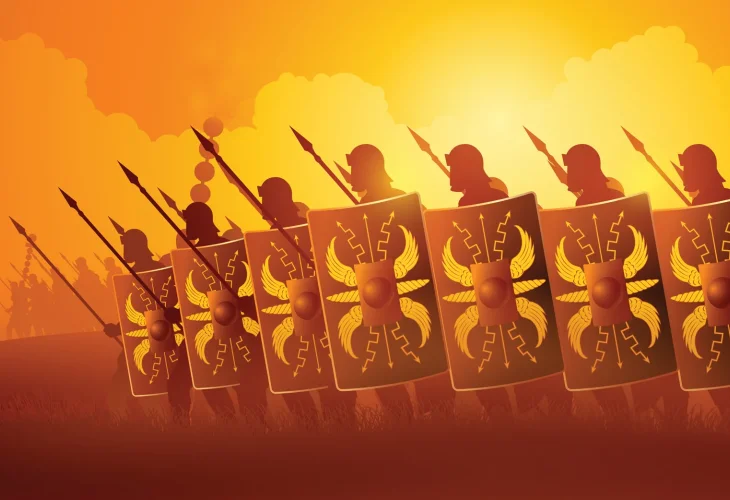From Power to Ruin: The Brutal Clash of King Yannai
King Yannai anticipated a fierce backlash when challenging the heart of the people, and preemptively stationed thousands of foreign mercenaries who emerged to massacre Jews. On that day, 3,000 innocent Jews perished to prove that Yannai was in charge, not religious law or the Oral Torah.
 (Illustration: shutterstock)
(Illustration: shutterstock)King Yannai's royal court reflected a Hellenistic dynasty with Greek cultural practices. His military leaders and advisors were influenced by Hellenism, making it difficult for Yannai to hold his ground against the Pharisaic Torah scholars. Unlike his father, John Hyrcanus, who minted coins reading "John the High Priest and the Council of the Jews," referring to the Sanhedrin, Yannai only imprinted his name, disregarding the Sanhedrin's authority.
Not only did he dismiss their authority, he was determined to prove he was the sole authority in the land, making decisions even on matters of religious law, being the High Priest.
During the holiday of Sukkot, a cherished commandment of water libation takes place, rooted in tradition from Moses at Sinai. Throughout generations, the Jewish people celebrated this with ancient ceremonies. They would descend to the Shiloah Spring with song and dance, and two children untouched by impurity would draw pure water. The procession would joyfully ascend to the Temple, marking the celebration with dance, torch-lit displays, and musical instruments. The High Priest poured the water on the altar, as tradition required.
After several years where Joshua Ben Gamla served as the acting High Priest, Yannai reclaimed the High Priesthood. After all the festivities and preparations, the priests handed Yannai the water vessels for the altar libation. Yet, in his arrogance, Yannai poured the water on his feet, influenced by the Sadducees who rejected the Oral Torah, and for them, anything not explicitly in the Torah did not exist.
Tens of thousands of Jews celebrating in the Temple were enraged. One threw his etrog at Yannai's head, and soon a storm of etrogim followed. Thousands were hurled at King Yannai, shattering part of the altar. Yannai, anticipating the uproar his actions would cause, had prepared thousands of foreign mercenaries who emerged from hiding and slaughtered the Jews. On that single day, 3,000 innocent Jews were killed to cement Yannai's rule over religious law and the Oral Torah.
The remaining Torah scholars understood that Yannai intended to kill them as well. Joshua Ben Perachiah fled to Egypt to escape Yannai's reach. Shimon Ben Shetach, head of the court, hid with his sister who was queen. The world seemed devoid of Torah. The Sadducees did as they pleased in the Temple.
King Yannai embarked on another military campaign against the Nabateans, near present-day Jordan. In an ambush, he found himself in distress. In Israel, people saw this as the moment to revolt against his oppression of the Torah scholars. Masses from across the land besieged Yannai’s forces in Transjordan, demanding his abdication in favor of a ruler who respected the law and the people's spirit.
Though Yannai initially defeated the rebels, the widespread rebellion continued. Wherever he turned, his army faced revolts. For six years, Yannai waged war against his own people. Fifty thousand Jews perished by his mercenary forces until the people, weary of Yannai's cruelty, hired Demetrius III of Syria. Seizing the opportunity, Demetrius defeated Yannai's army and entered Jerusalem triumphantly. Yannai, nearly bereft of allies, pleaded with Jerusalem's populace. How could they allow a foreigner to rule over Jerusalem and threaten the Hasmonean lineage, saviors from Greek rule? As Demetrius noticed some listening to Yannai, fearing betrayal, he declared his retreat. Yannai returned victorious to Jerusalem. On the advice of Diogenes the Sadducee, he ordered the crucifixion of 800 of the rebellion's leaders, watching the scene unfold alongside his wives, feasting and celebrating.
From Empire to Destruction (Part 1): The Hasmonean Revolt and Its Surprising Triumph
From Empire to Destruction (Part 2): The Dangerous Alliance that Toppled Judea
From Empire to Destruction (Part 3): John Hyrcanus' Stunning Victory over Antiochus
From Empire to Destruction (Part 4): The Decisive Battle Between Torah Sages and Sadducees
From Empire to Destruction (Part 5): The Rise and Fall of Aristobulus in Israel
From Empire to Destruction (Part 6): Battles, Victories, and the Famous Lasting Ordinance

